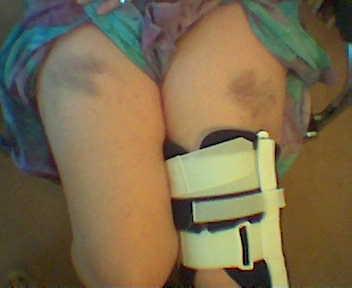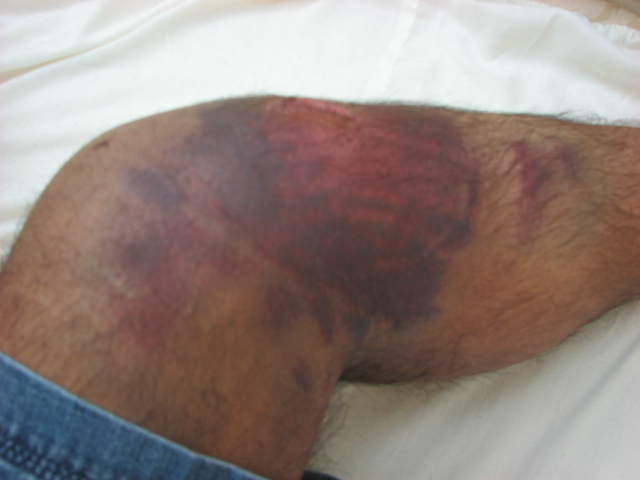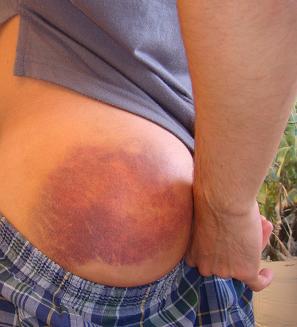Bruise
For patient information, click here
| Bruise | |
 | |
|---|---|
| Bruises from a ladder fall |
|
WikiDoc Resources for Bruise |
|
Articles |
|---|
|
Media |
|
Evidence Based Medicine |
|
Clinical Trials |
|
Ongoing Trials on Bruise at Clinical Trials.gov Clinical Trials on Bruise at Google
|
|
Guidelines / Policies / Govt |
|
US National Guidelines Clearinghouse on Bruise
|
|
Books |
|
News |
|
Commentary |
|
Definitions |
|
Patient Resources / Community |
|
Directions to Hospitals Treating Bruise Risk calculators and risk factors for Bruise
|
|
Healthcare Provider Resources |
|
Continuing Medical Education (CME) |
|
International |
|
|
|
Business |
|
Experimental / Informatics |
Editor-In-Chief: C. Michael Gibson, M.S., M.D. [1]
Synonyms and keywords: Contusion; ecchymosis; ecchymoma.
Overview
A bruise is an injury to biological tissue in which the capillaries are damaged, allowing blood to seep into the surrounding tissue. It is usually caused by blunt impact. Bruises often induce pain but are not normally dangerous. Sometimes bruises can be serious, leading to other more life threatening forms of hematoma, or can be associated with serious injuries, including fractures and internal bleeding. Minor bruises may be easily recognized, in people with light skin color, by their characteristic blue or purple appearance (idiomatically described as "black and blue") in the days following the injury.
The presence of bruises may be seen in patients with platelet or coagulation disorders. Unexplained bruising may be a warning sign of child abuse or serious medical problems, such as leukemia and meningoccocal infection. Unexplained bruising could indicate internal bleeding or certain types of cancer. A deficiency in Vitamin C can also make a person more susceptible to bruises from impacts. Also long term glucocorticoid therapy can cause easy bruising.
Classification
Based on Severity
Bruises can be scored on a scale from 0-5 to categorize the severity and danger of the injury.
| Harm score | Severity level | Notes |
| 0 | Light bruise | No damage |
| 1 | Light bruise | Little damage |
| 2 | Moderate bruise | Some damage |
| 3 | Serious bruise | Dangerous |
| 4 | Extremely serious bruise | Dangerous |
| 5 | Critical bruise | Risk of death |
The harm score is determined by the extent and severity of the fractures to the organs and tissues causing the bruising, in turn depending on multiple factors. A contracted muscle will bruise more severely, as can the tissues being crushed against underlying bone. Capillaries vary in strength, stiffness and toughness, which can also vary by age and medical conditions.
Causes
Drug Side Effect
- Azacitidine
- Azficel-T
- Cetrorelix
- Choline Magnesium Trisalicylate
- Dexamethasone
- Naproxen sodium
- Meprobamate
- Oxaprozin
- Penicillamine
- Prednisolone
- Prednisone
- Ruxolitinib
- Sodium phenylbutyrate
Light Bruises
At low levels of damage producing low-level bruising, the individual will feel some pain, either initially or delayed. The skin and surrounding region show inflammation, becoming red, tender and swollen due to the release of histamines. Repeated impacts worsen bruises, increasing the harm level. As time progresses, blood may escape and seep into the surrounding tissues even when the capillaries are being repaired, causing the bruise to darken and spread. During about the next two weeks, the bruise color changes to a dark red then to purple, black, or blue, eventually fading to yellow and disappearing as healing progresses. Some of these color changes are related to the breakdown of the hemoglobin in the escaped red blood cells. Normally, light bruises heal nearly completely on average in two weeks. Some may take a shorter or longer time and this is caused by random variation in the healing process;[1] more severe or deeper bruises may take longer. The striking colors of a bruise are caused by hemoglobin and its breakdown products, bilirubin and biliverdin.
Treatment for light bruises is minimal, including RICE, painkillers (particularly NSAIDs) and later in recovery, some light stretching exercises may be appropriate. If swelling is severe, swelling may be reduced by applying ice and / or by elevating the area. Rest and preventing re-injury is essential for faster recovery. Very gentle massage of the area may relieve pain and encourage blood flow, though pain may indicate the massage is exacerbating the injury.[2]
Moderate to Severe Bruises
If bruising is severe, (harm score 2-3) it may be dangerous, or it can cause serious complications. Further bleeding and excess fluid may accumulate causing a hard, fluctuating lump or swelling hematoma. This has the potential to cause compartment syndrome as the swelling cuts off blood flow to the tissues. Blunt trauma, which cause severe bruising by shock waves, may also cause other severe and fatal harm to internal organs. Impacts to the head can cause traumatic brain injury, bleeding, bruising and massive swelling of the brain with the potential to cause concussion, coma and death. Treatment may involve emergency surgery to relieve the pressure on the brain.
Bones may be broken by similar impacts, tendons can be bruised and joints can be sprained or otherwise harmed in ways that impair the functioning of the limbs. The symptoms and signs of these injuries may appear to be those of simple bruising. Severe injuries that cause difficulty in moving a limb, abdominal bruising and the feeling of liquid under the skin may indicate a life-threatening injury and requires the attention of a doctor.
If a severely bruised muscle is used too early before healing has occurred, bone tissue may form inside the muscle, causing permanent stiffness, pain and disability. Extremely severe bruises may take as long as a year to completely heal.
Diagnosis
Physical Examination
-
Bruise caused by a handrail, typical of extreme sports
-
Severe bruises caused by car accident
-
Bruised caused by a bad landing while snowboarding
Related Chapters
References
- ↑ Voorhees, Benjamin W. (2007-08-31). "Medical Encyclopedia - Bruise healing". Retrieved 2007-09-9. Check date values in:
|accessdate=(help) - ↑ "WebMD article on bruising".
Template:Injuries, other than fractures, dislocations, sprains and strains
Template:WH
Template:WS


